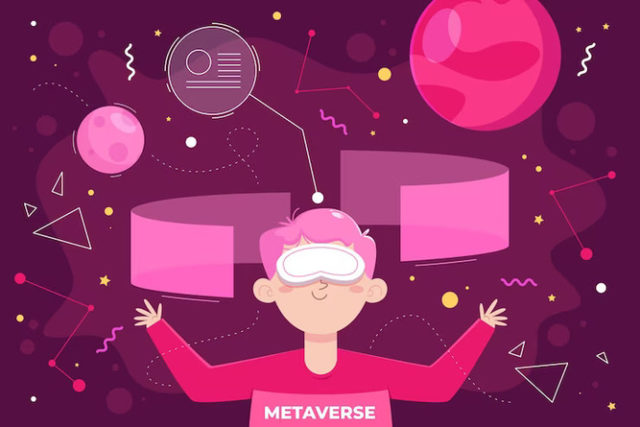A virtual world known as the “Metaverse” allows users to communicate with one another in real-time using avatars or digital versions of themselves. The term “virtual reality” (VR), “augmented reality” (AR), or other technologies are frequently used to refer to it as a completely immersive, three-dimensional online world. Users can take part in a variety of activities in the Metaverse, including socialising, gaming, marketing, learning, and even employment. Because of the development of technologies like VR and blockchain, which have also made it possible to create increasingly realistic and decentralised virtual worlds, the idea of Metaverse is becoming more popular.
How does the Metaverse operate?
The way Metaverse functions is by offering a virtual environment where users may communicate with one another in real-time, build and manipulate digital items, and even carry out cryptocurrency transactions. Many technologies, including a combination that creates the metaverse, are as follows:
- Virtual reality (VR) and augmented reality (AR): Virtual reality (VR) and augmented reality (AR) technologies let people interact with digital items naturally and intuitively while immersing themselves in virtual surroundings. These tools are necessary to build the fully immersive Metaverse experience.
- Blockchain: A decentralised, encrypted, and transparent ledger technology, blockchain enables safe transactions and the ownership of digital assets can be verified. Blockchain can be utilised in the Metaverse for safe virtual assets and good transactions as well as for maintaining the reliability of the virtual universe.
- Cloud computing: Cloud computing is crucial for supplying the enormous computational power and storage required to build and maintain the Metaverse’s virtual world. Moreover, cloud computing can facilitate seamless cross-location cooperation between consumers and developers.
- Spatial Computing: The ability of computers to perceive and comprehend the three-dimensional physical world is referred to as spatial computing. In order to create virtual environments that can interact with the real world and offer a seamless and realistic experience, this technology is necessary.
- Artificial Intelligence (AI): AI technologies are necessary for developing intelligent avatars and NPCs (non-playable characters) that can communicate with users in a genuine and natural way. AI can also be used to build intelligent virtual worlds that can change to accommodate human preferences and behaviour.
- 5g Networks: The real-time engagements that constitute the heart of the Metaverse experience require ultra-high-speed internet access with low latency, which is provided by 5G networks. Users on various devices and in various locations can communicate without any interruptions thanks to 5G networks.
What purposes does the metaverse serve today?
Although the idea of the metaverse has existed for quite a while, it has only just begun to materialise. There are several uses for the metaverse today, including:
- Video games: A number of well-known video games, like World of Warcraft and Second Life, might be seen as the earliest iterations of the metaverse. Players can explore virtual worlds, communicate with other gamers, and create avatars in these games.
- Socialising: A number of social media sites, like Facebook and Instagram, are starting to include features from the metaverse in their offerings. For instance, Facebook Horizon is a collaborative virtual reality platform that enables user interaction.
- Education and Training: Students can learn in a virtual world by using the metaverse as a resource for education and training. For difficult or hazardous tasks, like medical training or army simulations, this can be very helpful.
- Business: Organisations can utilise the metaverse to build virtual shops and showrooms where customers can browse merchandise and make purchases. Since purchasing in person is prohibited due to the COVID-19 pandemic, this can be extremely helpful.
The potential future of the metaverse
Although the metaverse is only an emerging idea, it has the power to completely alter how we communicate and interact with technology. As the virtual and augmented reality industry grows, it may be possible to provide a fully immersive experience that makes users feel genuinely present in a virtual environment. The metaverse might offer a setting for online communication and teamwork, immersive learning, and novel social interactions. It might also develop into a brand-new platform for trading digital products and services.
Conclusion
Several facets of our existence could undergo radical change as a result of the metaverse. It will be crucial for stakeholders to keep in mind the moral implications of this system as the metaverse develops and make absolutely certain it’s inclusive, transparent, and open to everyone. It’s up to us to mold the metaverse in a way that matches our goals and ideals even though it might be the future of human interaction.










































